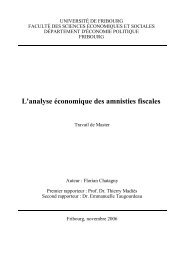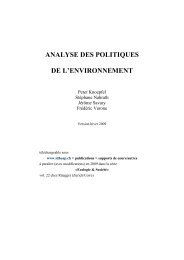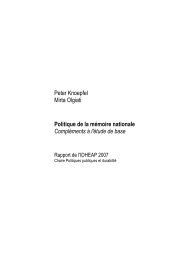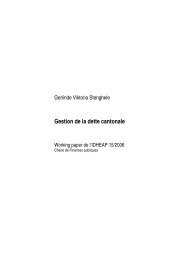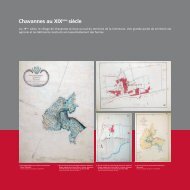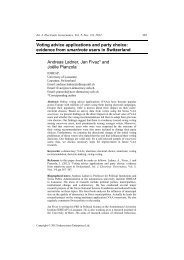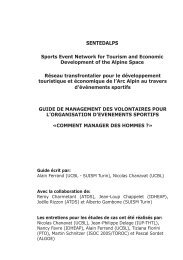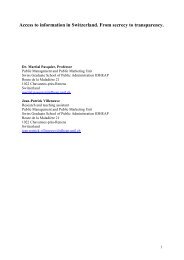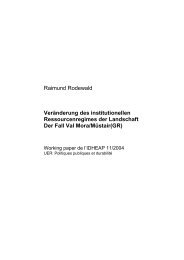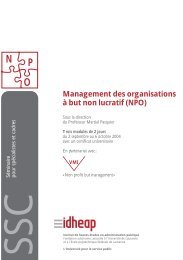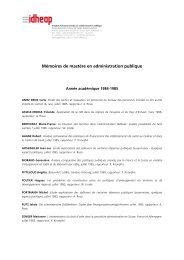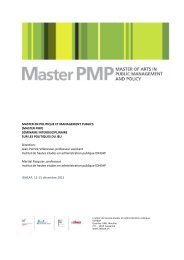Historical Analysis of Institutional Regimes in Switzerland ... - IDHEAP
Historical Analysis of Institutional Regimes in Switzerland ... - IDHEAP
Historical Analysis of Institutional Regimes in Switzerland ... - IDHEAP
Create successful ePaper yourself
Turn your PDF publications into a flip-book with our unique Google optimized e-Paper software.
27<br />
• The ga<strong>in</strong> <strong>in</strong> <strong>in</strong>sight associated with this comb<strong>in</strong>ed concept can be demonstrated as follows: for<br />
example, if one exam<strong>in</strong>es the property and use rights alone, the regulative system for the resource<br />
soil emerges as be<strong>in</strong>g “better” (related to the horizontal axis) than that for the resource water. If<br />
the policy design is exam<strong>in</strong>ed <strong>in</strong> isolation, the policy design for the resource water emerges as<br />
be<strong>in</strong>g “better” (related to the vertical axis) than the soil policy design. These contradictory<br />
conclusions are merely partial and can be overcome if the two dimensions <strong>of</strong> each IR are<br />
considered <strong>in</strong> conjunction.<br />
• With respect to practical utility, the comb<strong>in</strong><strong>in</strong>g <strong>of</strong> public policies and property rights gives rise to<br />
an enlargement or broaden<strong>in</strong>g <strong>of</strong> the steer<strong>in</strong>g potential <strong>of</strong> natural resources. As a result, it helps<br />
us to conceive new directions for the susta<strong>in</strong>able steer<strong>in</strong>g <strong>of</strong> natural resources (comprehensive<br />
and <strong>in</strong>tegrated management for resources). The comparison <strong>of</strong> the regimes reveals possibilities as<br />
to how control, and hence the <strong>in</strong>stitutional framework <strong>of</strong> the resource management, can be<br />
improved. Whereas, for example <strong>in</strong> the case <strong>of</strong> soil, co-ord<strong>in</strong>ation between the different policy<br />
areas would represent an urgent priority, <strong>in</strong> the case <strong>of</strong> air and landscape, the creation <strong>of</strong><br />
property rights would be an option. The proposals must be conceived <strong>in</strong> such a way as to allow<br />
new possibilities for susta<strong>in</strong>able use <strong>in</strong> the form <strong>of</strong> <strong>in</strong>cremental development. Property rights<br />
changes can only be provided if w<strong>in</strong>dows <strong>of</strong> opportunity are available.<br />
• Insights <strong>in</strong>to the status and the conditions <strong>of</strong> the formation <strong>of</strong> IRs also allow the consideration <strong>of</strong><br />
the external factors <strong>of</strong> the Common Pool Resources (CPR). Whereas many studies on CPRs<br />
describe the design pr<strong>in</strong>ciples <strong>of</strong> the management system itself, the external ecological, socioeconomic<br />
and - <strong>in</strong> particular - the political-<strong>in</strong>stitutional context are neglected. Futhermore, the IR<br />
concept considers the frame set by sectoral policies as important for the use <strong>of</strong> resources.<br />
• The identification <strong>of</strong> triggers will facilitate improved treatment <strong>of</strong> rival uses <strong>of</strong> public and mixed<br />
goods. This should provide further <strong>in</strong>sights <strong>in</strong>to where, when and on the basis <strong>of</strong> which political<br />
conditions the resource regimes change under the <strong>in</strong>fluence <strong>of</strong> politically perceived scarcity.<br />
• The examples from <strong>Switzerland</strong> show that <strong>in</strong> addition to their historical evolution, the IR features<br />
for the chosen resources differ (e.g. quantitative protection and the qualitative protection for the<br />
resource forest; qualitative protection and then quantitative protection for the resource water).<br />
The short discussion above also suggests that the more differentiated the IR, the better the<br />
protection provided for the natural resource. As already stated, tak<strong>in</strong>g <strong>in</strong>to account only one<br />
dimension <strong>of</strong> the IR concept (design or property rights) will not give the same results.



